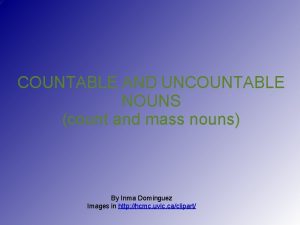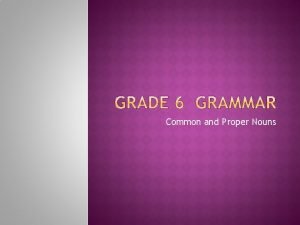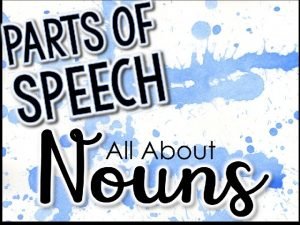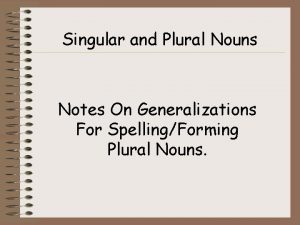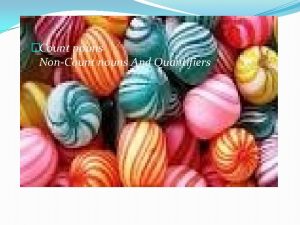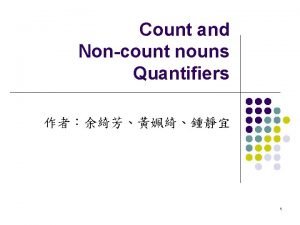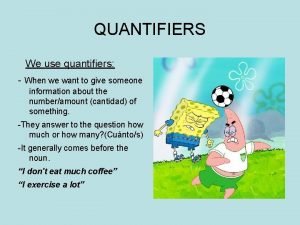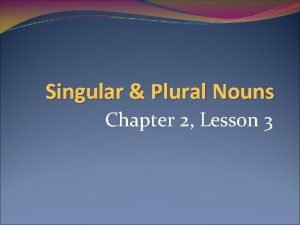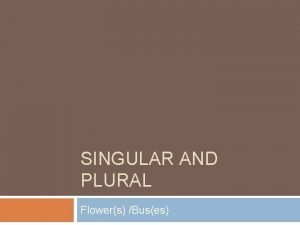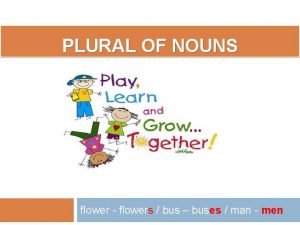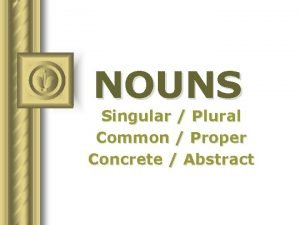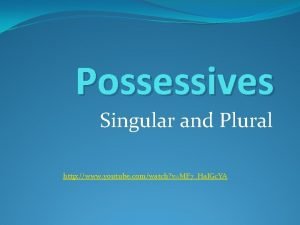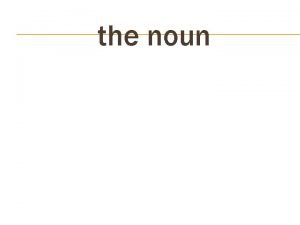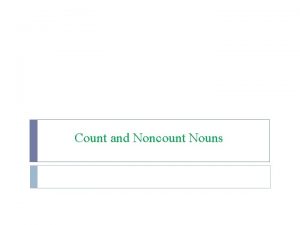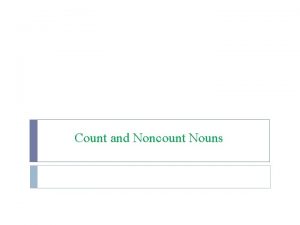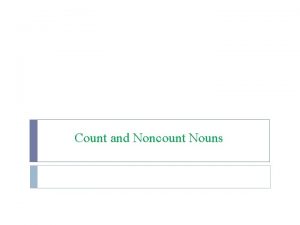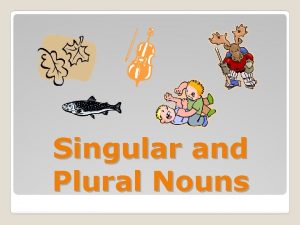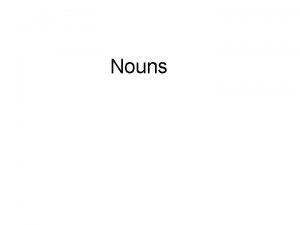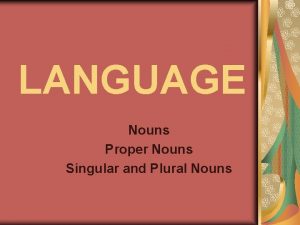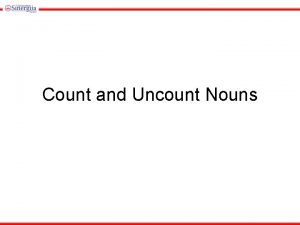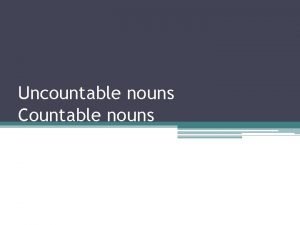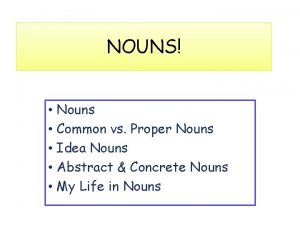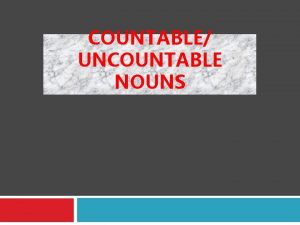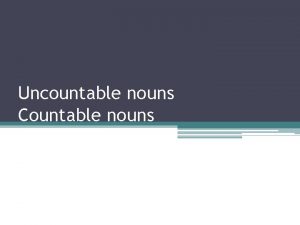7 1 Nouns Count and No Ncount SINGULAR

















- Slides: 17


7 -1: Nouns: Count and No. Ncount SINGULAR PLURAL ﺍﻷﺴﻤﺎﺀ ﺍﻟﻤﻌﺪﻭﺩﺓ COUNT NOUN A book One books two books Some books ﺍﻷﺴﻤﺎﺀ ﺍﻟﻐﻴﺮ ﻣﻌﺪﻭﺩﺓ NONCOUNT NOUN mail (no plural Some mail form) a lot of mail A COUNT NOUN SINGULAR: A , and + noun One + noun PLURAL: Noun + -s A NONCOUNT NOUN SINGULAR: Do not use a Do not use one PLURAL: A NONCOUNT NOUN dose not have a plural form Common noncount nouns : ﺍﻷﺴﻤﺎﺀ ﺍﻟﻐﻴﺮ ﻣﻌﺪﻭﺩﺓ ﺍﻟﺸﺎﺋﻌﺔ Advice Furniture Help Homework Information Jewelry Luck mail money music traffic vocabulary weather work bread cheese coffee food fruit meat milk pepper rice salt soup sugar tea water

Exercise: ﺗﻤﺮﻳﻦ 1. we have an assignment. (count) ( )ﻣﻌﺪﻭﺩ 2. I have some information a bout baas. (non count)( ﻏﻴﺮ ﻣﻌﺪﻭﺩ )

7 -2 : USING AN vs. A. (a, an) ﺍﺳﺘﺨﺪﺍﻡ (a) A dog an animal A and an are used in front of singular count nouns. In (a): dog and animal are singular count nouns. (b) I work in an office. (c) Mr. Lee is an old man. Use an in front of words that begin with the vowels a , e , I and o : an apartment , an elephant , an idea , an ocean. In (c): Notice that an is used because the adjective (old) begins with a vowel and comes in front of a singular count nouns (man). (d) I lave an uncle. COMPARE (e) He works at a university Use an if a word that begins with “u” has a vowel sound : an uncle, an ugly picture. Use a if a word that begins with “u” has ayu sound : a university , a usual event. . (f) I need an hour to finish my work. Compare : (g) I live in a house. He lives in a hotel. In some words that begin with “h” the ”h” is not pronounced. Instead, the word begins with a vowel sound an is used : an hour , an honor. In most words that begin with “h” the “h” is pronounced. Use a if the “h” is pronounced.

Exercise: ﺗﻤﺮﻳﻦ 1. Tom is eating a banana. 2. an hour has sixty minutes a

7 - 3: USING AAN vs. some (a) I have a pen. (b) I have some pens. ﺍﻻﺳﻢ ﺍﻟﻤﻔﺮﺩ ﻗﺒﻞ a, an ﻧﺴﺘﺨﺪﻡ ﺍﻟﻤﻌﺪﻭﺩ . ﻗﺒﻞ ﺍﻟﺠﻤﻊ ﺍﻟﻤﻌﺪﻭﺩ some ﻧﺴﺘﺨﺪﻡ AAn is used in front of singular count noun In (a) : the word pen is a singular count noun some is used in front of plural count noun In (b) : The word pens is a plural count noun (c) I have some rice ﺍﻷﺴﻤﺎﺀ ﺍﻟﻐﻴﺮ ﻗﺒﻞ some ﻧﺴﺘﺨﺪﻡ . ﻣﻌﺪﻭﺩﺓ Some is used in front of noncount nouns* In (c) : the word rice is a noncount noun.

EXERCISE : 1 - I see a desk in this room. 2 - I see some desk in this room.

7 -4 : MEASUREMENTS WITH NONCOUNT NOUNS: : ﺍﻷﺴﻤﺎﺀ ﺍﻟﻐﻴﺮ ﻣﻌﺪﻭﺩﺓ ﻣﻘﺎﻳﻴﺲ (a) I’d like some water. (b) I’d like a glass of water. (c) I’d like a cup of coffee. (d) I’d like a piece of fruit. Units of measure are used with noncount nouns to express a specific quantity. For example a glass of , a cup of , a piece of. In (a) some water =an unspecific quantity. In (b) a glass of water = a specific quantity. COMMON EXPRESSIONS OF ﻷﺸﻬﺮ ﺍﻟﻤﻘﺎﻳﻴﺲ : MEASURE : ﺍﻷﺴﻤﺎﺀ ﺍﻟﺸﺎﺋﻌﺔ a bag of rice. a bunch of bananas. a jar of pickles. a loaf of bread a bar of soap. a can of corn. . ottle of olive oil. a carton of milk. ; a piece of cheese. a sheet of paper. owl of cereal. a glass of water. a box of candy. a head of lettuce. a tube of toothpaste

EXERCISE: 1. a bowl of rice. 2. a piece of fruit.

7 -5: USING MANY, MUCH , A FEW, A LITTLE: many , much, a few, a little ﺍﺳﺘﺨﺪﺍﻡ (a) I don’t get many letters. (b) I don’t get much mail. (c) Ann gets a few letters. (d) Tom gets a little mail. In (a) many is used with PLURAL COUNT nouns ﻣﻊ ﺃﺴﻤﺎﺀ ﺍﻟﺠﻤﻊ ﺍﻟﻤﻌﺪﻭﺩﺓ many ﺗﺴﺘﺨﺪﻡ In (b) much is used with NON COUNT nouns ﺍﻷﺴﻤﺎﺀ ﺍﻟﻐﻴﺮ ﻣﻌﺪﻭﺩﺓ ﻣﻊ much ﺗﺴﺘﺨﺪﻡ In (c) a few is used with PLURAL COUNT nouns ﻣﻊ ﺃﺴﻤﺎﺀ ﺍﻟﺠﻤﻊ ﺍﻟﻤﻌﺪﻭﺩﺓ a few ﺗﺴﺘﺨﺪﻡ In (d) a little is used with NON COUNT nouns ﺍﻷﺴﻤﺎﺀ ﺍﻟﻐﻴﺮ ﻣﻌﺪﻭﺩﺓ ﻣﻊ a little ﺗﺴﺘﺨﺪﻡ


7 - 6 : USING THE : (the) ﺍﺳﺘﺨﺪﺍﻡ (a) A: Where’s David ? B: He’s in the kitchen. (b) A: I have two pieces of fruit for us an apple and a banana. Which do you want? B: I’d like the apple , thank you. (c) A: It’s a nice summer day today. The sky is blue. The sun is hot B: yes, I really like summer. (d) Mike has a pen and a pencil. The pen is blue. The pencil is yellow. (e) Mike has some pens and pencils. The pens are blue. The pencils are yellow. (f) Mike has some rice and some cheese. The rice is white. The cheese is yellow. A speaker uses the when the speaker and the listener have the same thing or person in mind. The shows that a noun is specific. In (a): Both A and B have be same kitchen in mind. In (b): When B says “the apple ” both A and B have the same apple in mind. In (c): Both A and B are thinking of the same sky (there is only one sky for them to think of) and the same sun (there is only one sun for them to think of). The is used with : ﺍﺳﺘﺨﺪﺍﻣﺎﺗﻬﺎ -singular count nouns , as in (d). ﺍﻻﺳﻢ ﺍﻟﻤﻔﺮﺩ ﺍﻟﻤﻌﺪﻭﺩ -plural count nouns , as in (e). ﺍﻻﺳﻢ ﺍﻟﺠﻤﻊ ﺍﻟﻤﻌﺪﻭﺩ -noncount nouns , as in (f). ﺍﻻﺳﻤﺎﺀ ﺍﻟﻐﻴﺮ ﻣﻌﺪﻭﺩﺓ In other words, the is used with each of the three kinds of nouns. ﺍﻻﺳﻤﺎﺀ ﺗﺴﺘﺨﺪﻡ ﻣﻊ ﺟﻤﻴﻊ ﺃﻨﻮﺍﻉ Notice in the examples: the speaker is using the for the second mention of a noun. When the speaker mentions a noun for a second time, both the speaker and listener are now thinking about the same thing. First mention: I have a pen. Second mention: the pen is blue.

7 -7 : USING Ø(NO ARTICLE) TO MAKE GENERALIZATIONS (a) Ø Apples are good for you. (b) Ø Students use Ø pens and Ø pencils. (c) I like to listen to Ø music. (d) Ø Rice good for you. b No article (symbolized by Ø ) is used to make generalizations with *plural count nouns , as in (a) and (b) *noncount nouns , as in (c) and (d) ﺍﻷﺴﻤﺎﺀ ﻻﻧﺴﺘﺨﺪﻡ ﺃﺪﺍﺓ ﺗﻌﺮﻳﻒ ﻗﺒﻞ ﺃﺤﻴﺎﻧﺎ - ﺍﻟﻤﻌﺪﻭﺩﺓ ﻭﺍﻟﻐﻴﺮ ﻣﻌﺪﻭﺩﺓ (e) Tom and Ann ate some fruit the apples were very good , but the bananas were too ripe. (f) We went to a concert last night the music was very good. Compare: n (a), the word apple is general. It refers to all apples , any apples. No article (Ø) is used. In (e), the word apples is specific , so the is used in front of it. It refers to the specific apples that Tom and Ann ate. Compare: In (c), music is general. In (f), the music is specific

EXERCISE : 1. Ø coffee is brown. 2. the pages in this book are full of grammar exercises.

7 -8 : USING SOME AND ANY STATEMENT (a) Alice has some money, ﺍﻟﺤﺎﻻﺕ ﻣﻊ some ﻧﺴﺘﺨﺪﻡ ﺍﻟﻤﺜﺒﺘﺔ Use some in affirmative statements. NEGATIVE (b) Alice don’t have any money ﺍﻟﺤﺎﻻﺕ ﻣﻊ any ﻧﺴﺘﺨﺪﻡ ﺍﻟﻤﻨﻔﻴﺔ Use any in negative statements. QUESTION (c) Dose Alice have any money? (d) Dose Alice have some money? Use either some or any in a question. ﻣﻊ some or any ﻧﺴﺘﺨﺪﻡ ﺍﻟﺴﺆﺎﻝ (e) I don’t have any money. (noncount noun) (f) I don’t have any matches. (plural count noun. ) ﺍﻷﺴﻤﺎﺀ ﺍﻟﻐﻴﺮ ﻣﻌﺪﻭﺩﺓ ﻭﺃﺴﻤﺎﺀ ﺍﻟﺠﻤﻊ ﺍﻟﻤﻌﺪﻭﺩﺓ ﻣﻊ any ﺗﺴﺘﺨﺪﻡ Any is used with noncount nouns and plural count nouns

EXERCISE: 1. I don’t have any money in my purse. 2. Ken needs some help.

References: -English grammar in use by Raymond Murphy -Interactions focus on Grammar - The Teacher's Grammar of English: A Course Book and Reference Guide, with answers - Ron Cowan | See in UK - The Mc. Graw-Hill Handbook of English Grammar and Usage | See in UK
 Count nouns clipart
Count nouns clipart Is california a proper noun
Is california a proper noun Pig common or proper noun
Pig common or proper noun Plural examples
Plural examples Quantifier of air
Quantifier of air Quantifiers non count nouns
Quantifiers non count nouns Count nouns and quantifiers
Count nouns and quantifiers Tricky singular and plural nouns
Tricky singular and plural nouns Objectives of singular and plural nouns
Objectives of singular and plural nouns Singular and plural notes
Singular and plural notes Flower in plural
Flower in plural Flower plural words
Flower plural words Uncountable noun singular or plural
Uncountable noun singular or plural Is women plural
Is women plural Plural abstract nouns
Plural abstract nouns Youtube possessive nouns
Youtube possessive nouns Singular plural list
Singular plural list Clothes singular or plural
Clothes singular or plural
